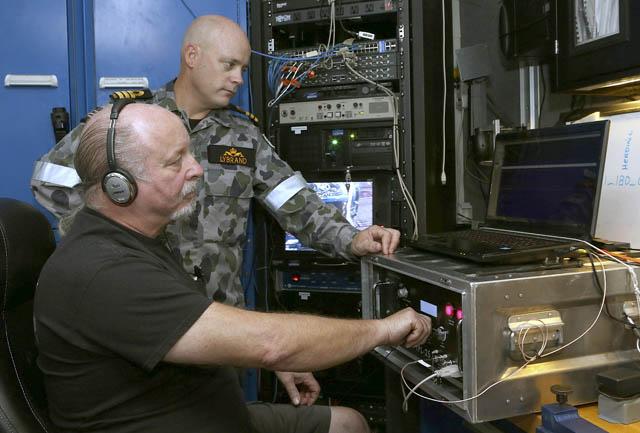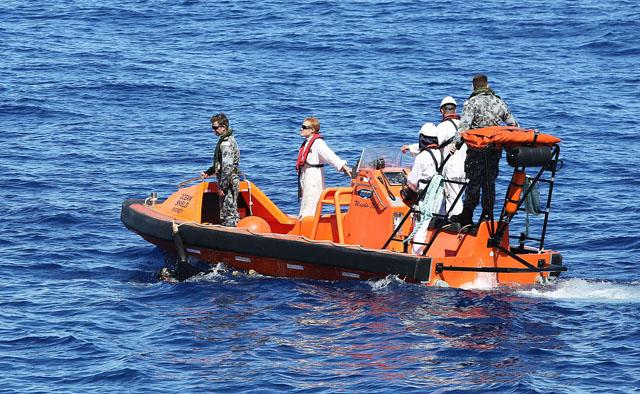You are here
Australia probes ‘encouraging’ signals in MH370 hunt
By AFP - Apr 06,2014 - Last updated at Apr 06,2014
PERTH, Australia — Ships searching the vast Indian Ocean for a Malaysian airliner have detected three separate underwater signals, and more ships and planes were diverted Sunday to investigate whether they could have come from its “black box”.
Angus Houston, head of the Australian search mission, said the detections were being taken “very seriously” as time ticked down on the battery life of the black box’s tracking beacons.
He said China’s Haixun 01 has twice detected an underwater signal on a frequency used for the plane’s flight data and cockpit voice recorders — once for 90 seconds on Saturday and another more fleeting “ping” on Friday a short distance away.
A third “ping” was also being scrutinised, 300 nautical miles away in the Indian Ocean.
The Malaysia Airlines Boeing 777 with 239 people aboard vanished on March 8 during a flight from Kuala Lumpur to Beijing.
“This is an important and encouraging lead but one which I urge you to continue to treat carefully,” Houston told reporters.
“We are working in a very big ocean and within a very large search area.”
“Speculation and unconfirmed reports can see the loved ones of the passengers put through terrible stress, and I don’t want to put them under any further emotional distress at this very difficult time.”
Britain’s HMS Echo and the Australian ship Ocean Shield — both equipped with black box locators — and Australian air force planes were being diverted to the area to help discount or confirm the Chinese signals, Houston said.
Ocean Shield was also investigating the signal it detected on Sunday in its current location, about 300 nautical miles north of Haixun 01, in waters far off Australia’s west coast.
Houston said the Chinese finding was more promising.
“I think the fact that we’ve had two detections, two acoustic events in that location, provides some promise which requires a full investigation,” he said.
Time running out
The hunt for the jet was refocused on the southern end of the search zone Sunday after corrected satellite data showed it was more likely the plane entered the water there.
Houston said the Haixun 01 was already operating in that more southerly zone.
Some analysts greeted the acoustic detections with optimism, saying a 37.5kHz signal can only be transmitted by an emergency beacon. But others were sceptical and said it was vital to find supporting evidence.
Houston said Haixun 01 was in waters about 4.5 kilometres deep, meaning “any recovery operation is going to be incredibly challenging and very demanding, and will take a long period of time” if the plane is found there.
Houston said time was critical.
“This is Day 30 of the search and the advertised time for the life of the batteries in the beacon is 30 days. Sometimes they last for several days beyond that — say eight to 10 days beyond that — but we’re running out of time in terms of the battery life of the emergency locator beacons.”
Up to 10 military planes, two civil aircraft and 13 ships were scouring the remote waters on Sunday, concentrating on about 216,000 square kilometres of the Indian Ocean around 2,000 kilometres northwest of Perth.
Houston insisted that China was “sharing everything that’s relevant to this search” with the lead authority and sidestepped questions over the Haixun 01’s location far from the other lead vessels in the search.
“China has seven ships out there, that’s by far the largest fleet of ships out there. I think we should be focusing on the positives,” he said.
Hope, scepticism over signal
In Kuala Lumpur more than 2,000 people including relatives held an emotional mass prayer Sunday for the safety of the passengers.
Orange-robed Buddhist monks chanted mantras for almost two hours, before about two dozen tearful relatives left the event.
Some family members still cling to hope in the absence of wreckage from the plane and are desperate for leads.
But Greg Waldron, Asia managing editor of Flightglobal publication, based in Singapore, said he was sceptical that the Chinese ship had picked up a pulse.
“There have been a lot of false leads in this story and we need to be extremely cautious with any information that comes,” he told AFP.
“I am very sceptical that the Chinese have found something so soon, given the vastness of the search area.”
Ravi Madavaram, an aviation analyst with Frost & Sullivan based in Kuala Lumpur, said most beacons used in the maritime and aviation industry had the same frequency and the ping could “likely” be from flight MH370.
“But the Chinese have not said exactly where the ‘ping’ is originating and where they detected it,” he said.
“The Chinese had previously given false alarms, so we need to verify from others before we can confirm that we have a ping.”
Malaysian authorities believe satellite readings indicate MH370 crashed in the Indian Ocean after veering dramatically off course for reasons that remain unknown.
A criminal probe has focused on the possibility of a hijacking, sabotage or psychological problems among passengers or crew, but there is no evidence yet to support any of the theories.
Related Articles
An Australian ship searching for a missing Malaysia Airlines jetliner has picked up signals consistent with the beacons from aircraft black box recorders, in what search officials said on Monday was the most promising lead yet in the month-long hunt.
Search crews in the Indian Ocean failed to pick up more of the faint underwater sounds that may have been from the missing Malaysian jetliner’s black boxes whose batteries are at the end of their life.
A Chinese ship involved in the hunt for the missing Malaysian jetliner reported hearing a “pulse signal” Saturday in Indian Ocean waters with the same frequency emitted by the plane’s data recorders, as Malaysia vowed not to give up the search for the jet.















